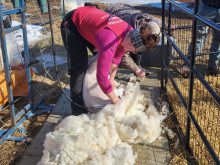Cattle exports to Russia resumed in 2007 after a long BSE-induced hiatus, and last year’s $14 million in sales is just the beginning, says Canada’s agriculture minister.
“The sky is the limit. It’s as many as we can spare,” Gerry Ritz said during a conference call with reporters while on a recent trade mission to Russia.
“My concern is that we will run out of (animals) and not be able to fill the market to the extent that they want.”
Russia imported more than 5,000 Canadian cattle last year. Ritz said the country is looking to reconstruct its national beef and dairy herds and sees Canada as a prime supplier of genetics.
Read Also

Charges laid after cattle theft
Saskatchewan RCMP lay two charges against a man after six cattle went missing.
“They want to come over and start buying more and more live cattle to augment their herds here and get those better returns per animal as Canadians have been doing.”
Ritz said he spoke to an importer who wanted to buy a number of genetically superior beef cattle from Western Canada.
Ritz also told reporters there should be a substantial market for processed beef products in Russia as the economy continues to grow.
According to Nathan Hunt, president of the Moscow chapter of the Canada Eurasia Russia Business Association, almost all of the 5,000 animals that made the long trip last year were dairy cattle and he doesn’t believe the market for beef cattle or processed beef will be that large.
He said Russia has invested heavily in the country’s livestock sector in recent years in an effort to rebuild what had become a moribund sector of its agricultural economy. It has successfully resurrected the poultry sector and is just starting to reap the rewards of its investment in pork.
There is talk of a similar revitalization project for the beef sector, he added, but that is a year or two away and will take five to 10 years to complete, which will limit the need to import breeding stock from Canada.
Hunt doesn’t see an emerging market for processed beef either. Thick, juicy steaks made from Canadian grain-fed cattle are too expensive for Russian tastes. They prefer to eat sausages, which require large volumes of cheaper meat. The beef used in those sausages generally comes from South America.
“Processed beef has never been big because Canadian beef is too high quality,” said Hunt.
However, Russia continues to be a significant market for Canadian pork, and Hunt said Ritz’s visit directly resulted in $11 million of trade on that front.
Everything in Russia happens on a face-to-face basis, he said. Russians don’t conduct business by fax or e-mail so when a high-ranking government official shows up, it has a big impact.
“We’re very pleased that the minister took this visit,” he said.

















